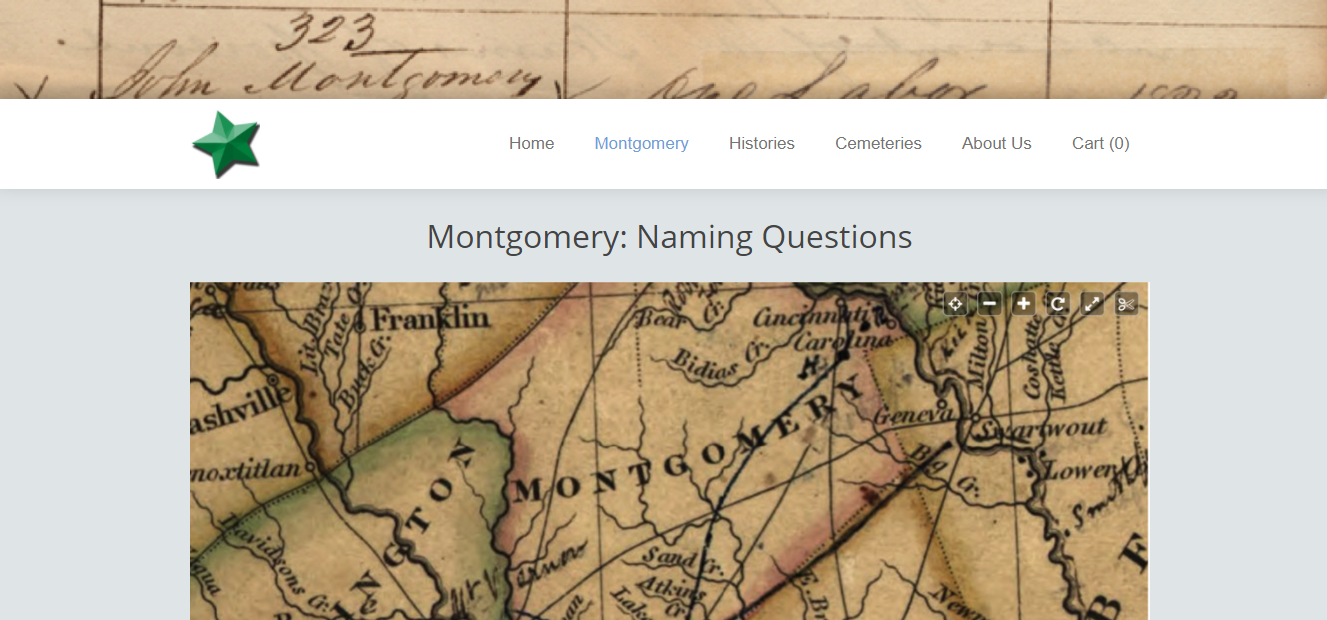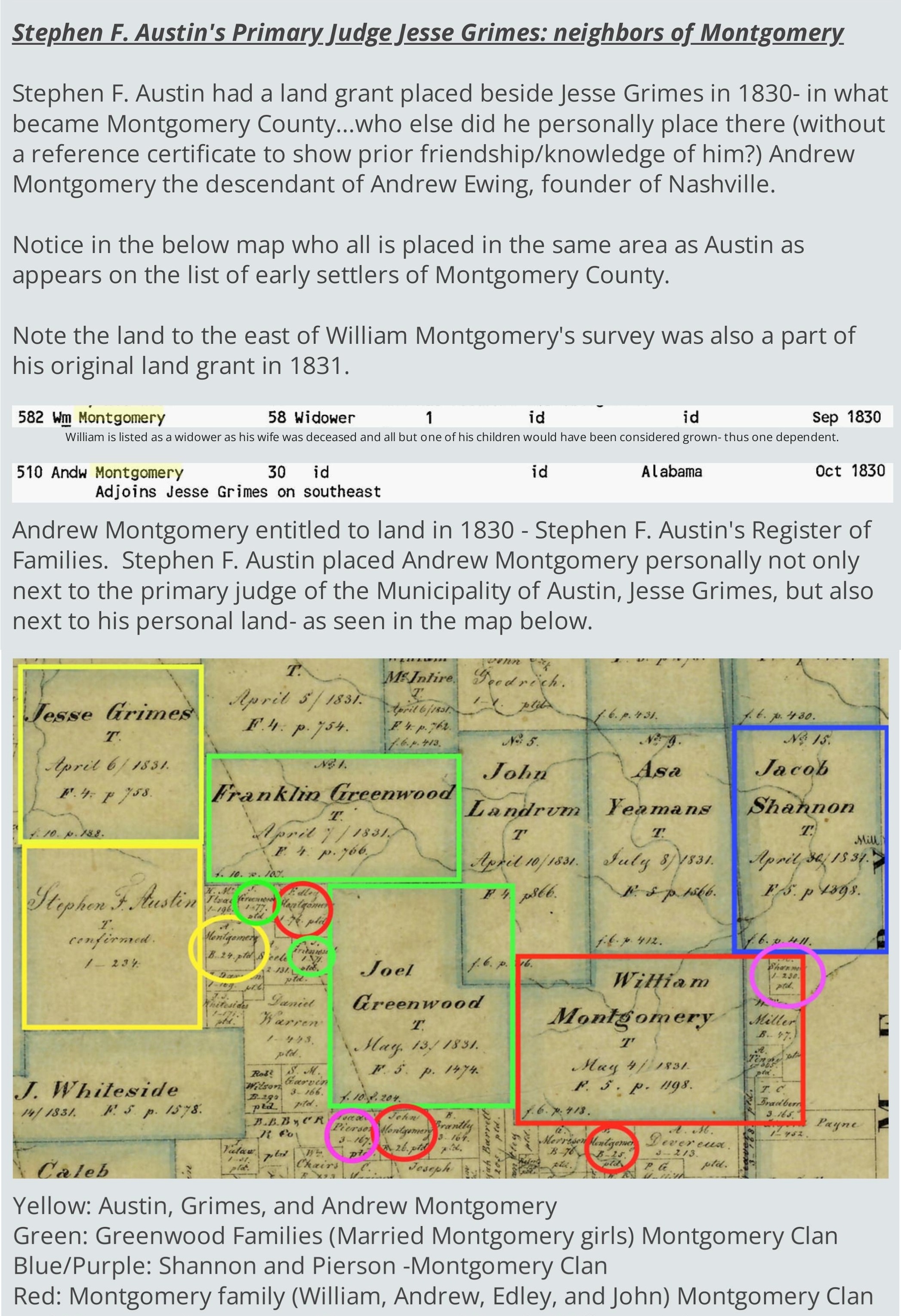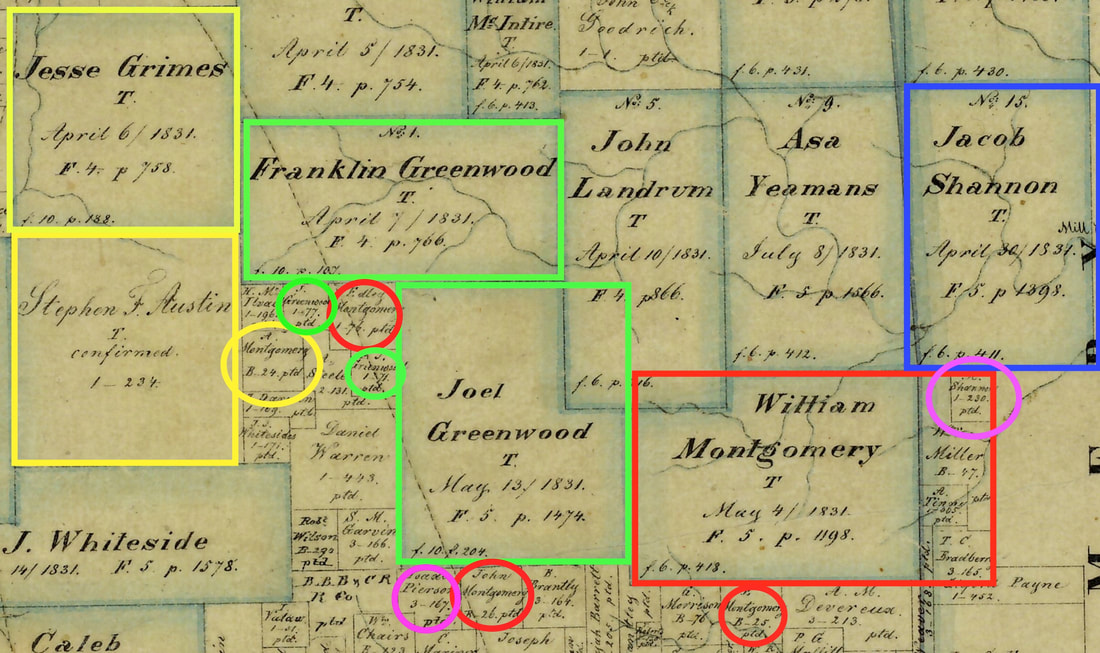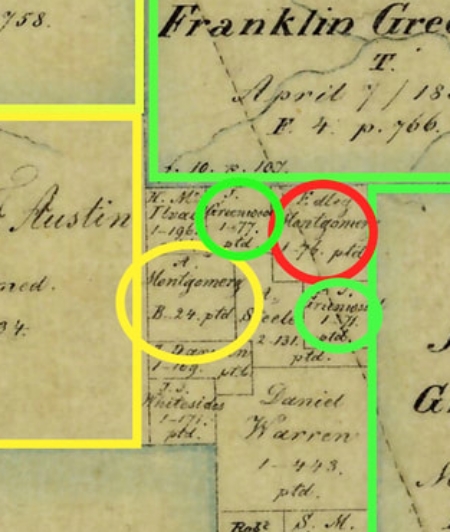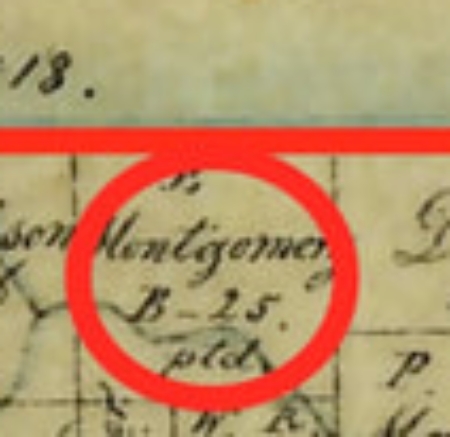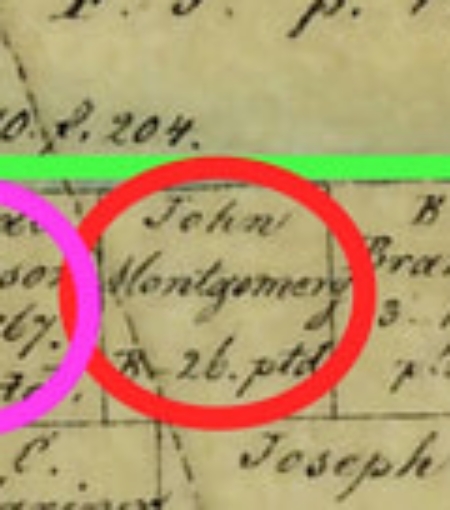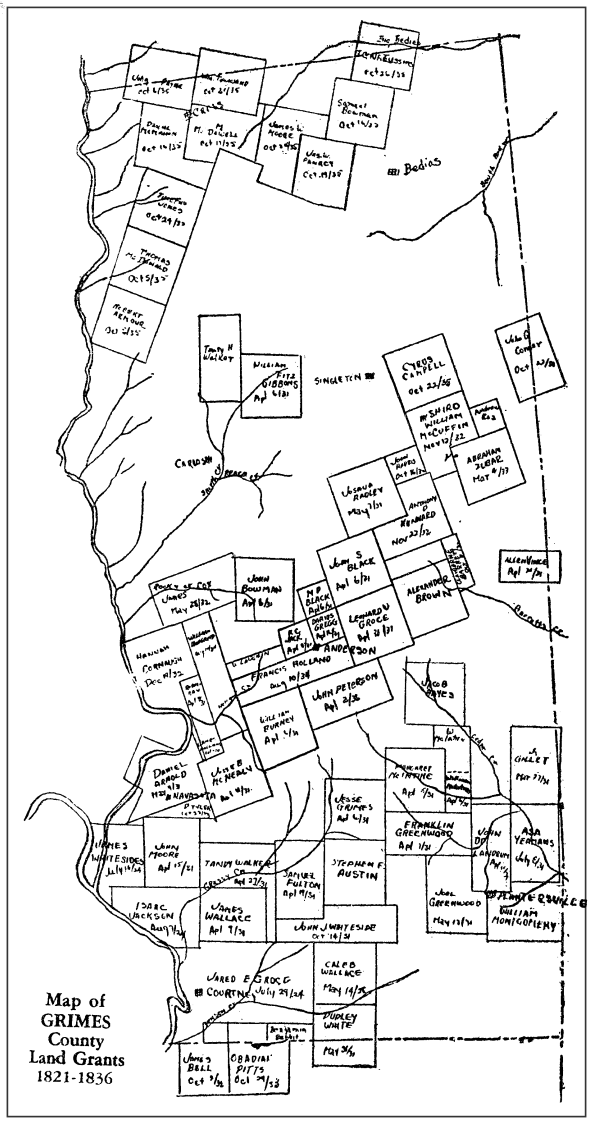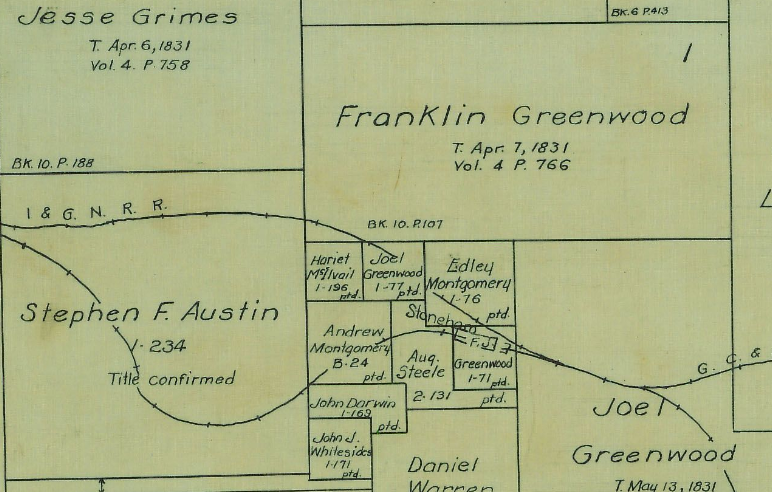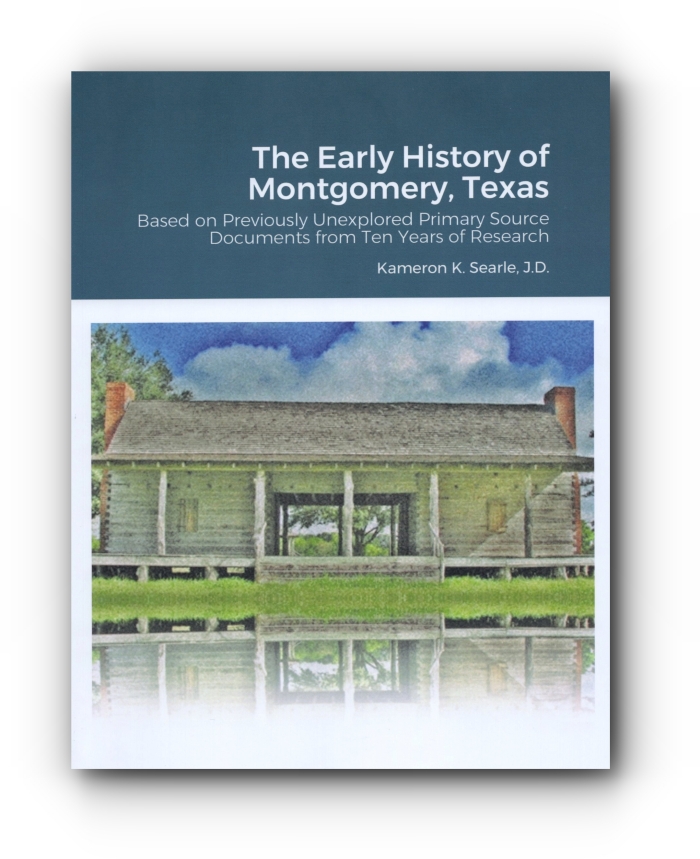
Andrew Montgomery Never Received a Land Grant From Stephen F. Austin
by Kameron K. Searle Andrew Montgomery never received Mexican land grant from Empresario Stephen F. Austin in any of Austin's Colonies! He was in fact a colonist in another colony, Robertson's Colony, and did not receive a Mexican land grant until 1835. The information below with the gray background was accessed on September 9, 2020 from http://www.texascenterforregionalstudies.net/montgomery.html and is from the webpage titled Montgomery: Naming Questions. The webpage indicated that it was submitted by Robin Navarro Montgomery and Joy Renee Montgomery. It is reproduced here just as it appeared on September 9, 2020.
Andrew Montgomery Never Received a Land Grant from Stephen F. Austin If you're like me, the impression it would seem one is supposed to get after reading the information above is that Andrew Montgomery arrived in Austin's Colony in 1830 and received the land grant with the yellow circle around it from Empresario Stephen F. Austin. Alas, this is not so! He did not receive this land grant or any other land grant from Stephen F. Austin. Andrew Montgomery registered with Stephen F. Austin in 1830, but for whatever reason, NEVER received a single land grant from him.
Note that this is not an 1830's map or a Stephen F. Austin Colony Map. Robin and Joy Montgomery used an 1858 Map of Grimes County for this illustration. Texas had been a State for 12 years when this map was created. As the original primary source documents in the Texas General Land Office clearly show, Andrew Montgomery received a military bounty for 320 acres of land for his service in the Texas Army during the Texas Revolution. It is important to note that the land circled in yellow on the map above shows "A. Montgomery, B-24.ptd." The abbreviation B-24. refers to Bounty File #24 which you can can see for yourself if you just click the link.
Enlargement of A. Montgomery, B-24.ptd. Andrew Montgomery, Bounty Grant #24 The bounty grant (Land Certificate #2105) for the land circled in yellow was signed in 1838 and entitled Andrew Montgomery to 320 acres of land somewhere in the Republic of Texas. But, the land was not patented to Andrew Montgomery until 1841. A patent is the legal instrument transferring land from the public domain to private ownership. Click on the image above and look at the Texas General Land Office records very closely. Now, whether Andrew Montgomery actually received this land in 1838, which the records clearly suggest he did not, or if he received the land in 1841 after paying his taxes, which the records clearly suggest he did, he did not receive this tract of land from Stephen F. Austin. Andrew Montgomery was not a colonist in any of Austin's Colonies/Empresario Grants. Andrew Montgomery was in fact a colonist up in Sterling C. Robertson's Colony. Andrew Montgomery received his Mexican Land Grants on February 2, 1835 and July 30, 1835 in Sterling C. Robertson's Colony (in present day Falls County) about 100 miles from the location of the tract of land circled in yellow on the map. I must stress, so that no one is left with any mistaken impressions, Andrew Montgomery did not receive the land circled in yellow on this map from Stephen F. Austin and Andrew Montgomery did not receive the land circled in yellow on this map from the Republic of Texas until after the town of Montgomery had already been founded! And, of course, Andrew Montgomery did not own this land prior the creation Montgomery County! The town was founded in July of 1837. The county was created in December 1837. This land was not the source of the name of the town or the county!
Montgomery Brothers Were Latecomers Enlargement of E. Montgomery, B-25.ptd. Edley Montgomery, Bounty Grant #25
Enlargement of John Montgomery, B-26.ptd. John Montgomery, Bounty Grant #26 From the larger map above, please see the enlargement of the red circled tract of land underneath William Montgomery's
land grant that
reads "E.
Montgomery, B-25.ptd." Also see the enlargement of the red circled tract of land under Joel Greenwood's land grant that
reads "John Montgomery,
B-26.ptd."
Andrew, Edley and John Montgomery had gone to Sterling C. Robertson's Colony (originally Robert Leftwich's Colony) during
the Mexican Colonial period. They lived there and received Mexican land grants there in 1835. E. Montgomery, B-25.ptd and John Montgomery, B-26.ptd.,
like A. Montgomery, B-24.ptd, are not Austin Colony land grants. These bounty grants were for military service to the Republic of Texas. Andrew, Edley and John did not own these tracts of
land in 1830, 1831, 1832, 1833, 1834, 1835, 1836 (during the Mexican Colonial period), or in 1836, 1837 (during the Republic of Texas period). It
certainly appears that they did not even own these tracts of land until 1841, when they paid their taxes. The town of Montgomery was founded in
July of 1837. The County of Montgomery was created in December of 1837. Whether they received
these tracts in 1838 or 1841, they did not own them until after the town was founded and the county had been created. The Montgomery brothers
were latecomers to the area, and as such, could not possibly have been the source of the name of the town or the county. Click these links to see Edley
Montgomery's and
John Montgomery's Mexican land
grants in Robertson's Colony in 1835 (located in Falls County today). Some Incorrect Statements Let's look at a couple of statements that were made in the section titled Stephen F. Austin's Primary Judge Jesse
Grimes: neighbors of Montgomery on the webpage Montgomery: Naming Questions.
Let's start with the first sentence in the section: All grammar issues aside, let's look at what this sentence appears to be trying to say and/or ask. The first part states that
"Stephen F. Austin had a land grant placed beside Jesse Grimes in 1830." A quick look at the map will show that this statement is incorrect. The Jesse
Grimes tract which is the one with the yellow square drawn around it shows that Jesse Grimes received his land grant on April 6, 1831, not in
1830. Also, if anyone got the impression from the article that Stephen F. Austin lived on his land grant shown on the map, he
didn't. Austin owned many huge land grants all over his various colonies that he had received from Mexico for his services as Empresario.
See The Texas General Land Office online Land Grant Search.
Fill out the "Original Grantee" field. The name must follow this format: Austin, Stephen. Your search will return 125 results for that name. Many of
these tracts are for leagues of land (4,428.4 acres each). Also, read any biography of Stephen F. Austin to see that he lived in San Felipe de Austin
during his time in Texas. In the middle of the sentence, it appears to turn into a question, "...who else did he [Stephen F. Austin] personally place
there...? The answer to the question that is given is, Andrew Montgomery. As we saw above, Stephen F. Austin did not "personally place" Andrew Montgomery
anywhere. Andrew Montgomery never received a land grant from Stephen F. Austin in 1830 or at any other time. Let's look at another sentence from the
article: This sentence gives the reader the impression that Austin "placed" everyone whose property is circled or outlined in
color on the map. This is not correct. Andrew, Edley and John Montgomery were not placed by Stephen F. Austin as they did not receive grants from him.
See the article, Montgomery Brothers Were Latecomers above. Let's look at one more section of the article: Being listed in Stephen F. Austin's Register did not entitle a person to land in Austin's Colony. As we have
seen, Andrew Montgomery was not "entitled to land in 1830" or at any other time from Stephen F. Austin. Austin did not place Andrew Montgomery
"next to" Jesse Grimes or Austin. The Republic of Texas won its independence, Austin's Colony ceased to exist and Stephen F. Austin died
in 1836, years before Andrew Montgomery received his military bounty grant which just happened to be located next to a tract of land that
Stephen F. Austin had once owned. Alas, Stephen F. Austin and Andrew Montgomery were never neighbors! Map showing the location of the land grants of the members of Stephen F. Austin's Colony who settled in what
is now Grimes County. Andrew Montgomery's bounty grant was, of course, not one of these grants. Please note that in E. L. Blair's book
Early History of Grimes County Andrew Montgomery is not a significant historical figure. An "Andy" is only mentioned once on page 132
in a list of William Montgomery's children. An "Andrew Montgomery" is listed as a son of Edley Montgomery on page 133. 1922 Map Showing Unincorporated Community of Stoneham in Grimes County, Texas Andrew Montgomery's 320 acre tract, patented in 1841, is located west
of Stoneham on this map.
In both the 1970 census and the 2000 census, unincorporated Stoneham had a population of 12. Just the Place for a Snark! There are numerous statements to the effect that Stephen F. Austin placed Andrew Montgomery next to
his property in 1830 or 1831 on the webpage titled Montgomery: Naming Questions. Here are several examples. As concerns Andrew Montgomery,
none of these statements are true. These are examples of a historical fallacy that Pulitzer Prize winning historian David Hackett Fischer
refers to on page 302 of his book Historians' Fallacies: Towards a Logic of Historical Thought
(New York: Harper and Row, 1970) as an argument ad nauseam. Fischer describes argument ad nauseam as "a serious error, in which a thesis is sustained by repetition
rather than by reasoned proof. This strategy was a favorite of Lewis Carroll's immortal Bellman
in The Hunting of the Snark." "Just the place for a Snark!" the Bellman cried As he landed his crew with care; Supporting each man on the top of the tide By a finger entwined in his hair. "Just the place for a Snark!" I have said it twice: That alone should encourage the crew. "Just the place for a Snark!" I have said it thrice: What I tell you three times is true." The Complete Works of Lewis Carroll, p.757 In an effort to put this issue to rest forever, I encourage all readers to prove for themselves that Andrew Montgomery never
received a Mexican land grant from Stephen F. Austin in 1830, 1831 or at any other time and that all such statements are simply not true. I will show
you how. It's easy. The Texas General Land Office is the repository for the original Spanish and Mexican land titles in Texas. Please go to the
Texas General Land Office Land Grant
Database:
https://s3.glo.texas.gov/glo/history/archives/land-grants/index.cfm. The Texas General Land Office files for the Mexican colonial period and the
Republic of Texas period have been digitized and can be accessed online. Fill out the "Original Grantee" field. The name must follow this
format: Montgomery, Andrew. Your search will return 21 results for that name. To the right side of each search result, you'll see a link to a PDF to
access the scanned file. There are only two Mexican land grants indicated in the search results. Andrew Montgomery received these grants while living
as a colonist in Robertson's Colony (today Falls County) in 1835. He received both of these land grants in the town of Viesca
(Sarahville de Viesca). See search results
Falls 42 Title SC 000037:49 and
Falls 41 Title SC 000037:50. There are NO OTHER Mexican land grants in the search results. So, there are no Mexican land
grants from Stephen F. Austin to Andrew Montgomery! It's just that simple. Also see Andrew Montgomery's military bounty
grant
Grimes 356 Montgomery Bounty 000024 in the search results. The Republic of Texas land certificate (#2105) was issued in 1838, two years after
Austin's Colony had ceased to exist. This bounty grant was patented by the Republic of Texas to Andrew Montgomery in 1841, five years after Austin's
Colony had ceased to exist. A patent is the legal instrument transferring land from the public domain to private ownership. Also, see the
articles Andrew Montgomery Never Received a Land Grant from Stephen F. Austin and Montgomery Brothers Were
Latecomers above. There were NEVER any Mexican land grants from Stephen F. Austin to Andrew Montgomery EVER. All statements to the effect
that Stephen F. Austin granted Andrew Montgomery land next to his or anywhere else in 1830 or at any other time are simply just not true
and never will be no matter how often they are repeated! Patents represent the last step in the land grant process, as the patent is the document that officially severs land from
sovereignty. The Patent Collection at the Land Office is among the most important collections of documents in Texas because in many cases,
the administrative copies of patents found at the Land Office are the only ones that exist. The Texas General Land Office https://www.glo.texas.gov/history/archives/services/index.html History is, among other things, an argument based on sources and evidence that support that argument. Historians are not free to
tell a story or make up an argument without supporting evidence. The evidence of the sources is the raw material of history and the historian's
most valuable tool. Historians should not argue or narrate beyond what the evidence demonstrates is the truth. The Historian's Toolbox: A Students' Guide to the Theory and Craft of History Robert C. Williams (M. E. Sharpe, Armonk, New York, 2007), p. 56 "It ain't what you don't know that gets you into trouble. It's what you know for sure that just ain't so." Attributed to Mark Twain In one of my articles
[in the Montgomery County News newspaper], I
had mentioned that William Harley Gandy had interviewed J. L. Montgomery of Richards, Texas while writing his
master’s thesis in 1952. I had questioned the fact that Robin Montgomery’s grandfather J. L. Montgomery made
no mention of an Andrew Montgomery trading post in his interview with Gandy. In this 1952 interview, J. L.
Montgomery had advised William Harley Gandy that Montgomery County was named after a surveyor named William
Montgomery. In his 1952 master’s
thesis, Gandy wrote, “Another local story has it that Montgomery took its name from William Montgomery, a
surveyor and widower, who came to Texas in 1822 with his sons…. In 1830, he settled some seven miles southwest
of the town of Montgomery in what is present day Grimes County…. It is claimed by the descendants of these two
brothers [John and Andrew] that the county was named for the surveyor William Montgomery.” In 1975, after 152 years of silence, from the alleged date it was founded, the Andrew
Montgomery Trading Post sprang forth in Robin Montgomery’s book, The
History of Montgomery County (Austin: Jenkins Publishing Co., 1975) complete in every detail for the very
first time anywhere. On page 285 of The History of Montgomery County, Robin Montgomery wrote, “This
book has shown that the reason the town and county came to be named for Andrew Montgomery lies in the events
surrounding his trading post.” Robin goes on to write, “Andrew
immediately set about encouraging settlers to venture down these roads to become his neighbors and clientele.
In this manner Andrew’s Trading Post became the major pivot point around which the settlement of the later
Montgomery County region revolved. Andrew’s last name became a unifying element among the gradually expanding
circle of settlement.” In my article, I had asked why
J. L. Montgomery, nor any other member of the William Montgomery family, had ever made any mention of this
Andrew Montgomery Trading Post before 1975. If the trading post was established in 1823, how is it that no
one ever mentioned it for 152 years until 1975? In his May 20, 2009 letter to the
editor, Robin attempts to address this question and provides a most extraordinary answer with ramifications that
would seem to completely undo Robin’s history of the Andrew Montgomery Trading Post. I do not believe I could
have written a more critical or damaging statement regarding this portion of Robin’s history than he himself has
written. My contention is that a couple of Robin's comments in his letter to the editor
completely undo his history of the Andrew Montgomery Trading Post and reveal it for what it is: family
fiction rather than family tradition. Robin's grandfather, J. L. Montgomery, clearly knew nothing about
an Andrew Montgomery Trading Post when Gandy interviewed him in 1952. It is Robin's response to this
point in his letter to the editor that wreck's his history. Please read this very carefully. In his May 20, 2009 letter to the editor, Robin
wrote: “…the William-Andrew Montgomery descendants did
not know of the Shannon tradition until the Historicade in Conroe in 1949. When actors in that ceremony stated
that the town was begun by a Montgomery Trading Post operated by the Shannon’s, as a child I heard the elder
members of my family exclaim, “They have forgotten William and Andrew!”” “Hence the family pieced together the logical
sequence that, if Shannon tradition ran true, the Shannon’s assumed a facsimile of the business which Andrew, by
then into surveying, had pioneered years earlier, and given that Owen Shannon’s wife’s maiden name was
Montgomery, continued the name.” “Also during the early fifties, from an elderly
relative the family received a book of notes since referred to as the Crittendon papers. It included an excerpt from the family Bible reinforcing oral tradition:
“Andrew rode with Dr. Long [Long Expedition 1819-1820] Started Montgomery Settlement.” Accordingly, during this
period of reassessment the Montgomery family began to consider Andrew rather than the patriarch, William as the
probable basis for the naming of the town.” Fascinating! J. L. Montgomery had the opportunity to set the record straight in his
interview with William Harley Gandy in 1952. But, as upset as
the Montgomery Family allegedly was following the 1949 Historicade, J. L. Montgomery made no mention to Gandy
of any trading post operated by the Montgomery family in the 1820’s. Robin then admits
that the Montgomery “family pieced together the logical sequence that if Shannon tradition was true, the
Shannon’s assumed a facsimile of the business which Andrew…had pioneered years earlier…” Robin amazingly admits the Montgomery family incorporated the Shannon
family tradition of a Montgomery Trading Post directly into the Montgomery family tradition. No fact checking
was done. It just says, “that, if Shannon tradition ran true.” Whether it was true or not, Robin informs
us that the Montgomery family incorporated the Shannon tradition into their own family tradition.
Though unchecked, the Shannon's Montgomery Trading Post story was obviously a very popular idea, so the
Montgomerys just included it into their story. Robin then mentions an excerpt from “the family Bible.” He wrote that the Crittendon
papers “included an excerpt from the family Bible reinforcing oral tradition: “Andrew rode with Dr. Long
[Long Expedition 1819-1820] Started Montgomery Settlement.”” We are left with a great many questions about this “excerpt from the family Bible” and
the Crittendon papers. Why is this excerpt not mentioned in Robin’s 1975 book or any book or article written
by Robin since 1975. Why is this excerpt coming to light for the
first time in May of 2009. Whose family bible was this? Who
wrote the note? Whose handwriting is the note in? What is the
provenance of this family Bible? Why has no one been allowed to
see this excerpt or the Crittendon papers since 1975? Is there anything about the excerpt that tells us where
the “Montgomery Settlement” was supposed to have been? Will Robin Montgomery allow us to see the Crittendon
papers or this excerpt in order to judge their historical value? Then Robin writes the most extraordinary statement of all: “Accordingly, during this period of reassessment the Montgomery family began to
consider Andrew rather than the patriarch, William as the probable basis for the naming of the
town.” The Montgomery family
changed their story altogether “during this period of reassessment” in the 1950’s! “During this period of reassessment,” they reject J. L. Montgomery’s family
history that says the surveyor William Montgomery is the source of the name of the county and they “began to
consider Andrew…as the probable basis for the naming of the town.”
Not only did the Montgomery family change the story, but they also guessed! After about 125 years, the
Montgomery family threw out the family tradition of William Montgomery as the source of the county's name after
watching a play in 1949 and receiving the mysterious and unproven "Crittendon papers." The
Montgomery family arbitrarily changed, in the 1950's, what had allegedly been handed down in the
Montgomery family from one generation to the next for 125 years. Up until 1952, the
Montgomery family tradition, of which we have a snap shot from Gandy’s thesis, was that the source of the name
of the county was the surveyor William Montgomery, not a trading post. After 1952, the Montgomery family rejects
their family tradition received from Robin’s grandfather, J. L. Montgomery. They incorporate much of the Shannon family tradition regarding a so-called
Montgomery Trading Post that was not present in the 1952 interview, and then they guess that Andrew must have
been the probable basis of the naming of the town. Wow! Knowing now what Robin has told us, is anybody still on board with the Andrew
Montgomery Trading Post at this point? It is not what someone else or I have written or speculated. This is clearly what
Robin Montgomery has written himself. Robin’s quote is out there for all to consider and critique
forever. As I stated earlier, I believe Robin has completely undone the main historical premise of
his entire book. The Montgomery family can't just decide to
completely rework their family tradition into something brand new during the 1950's and then insist that it
is a valid historical source or oral family tradition dating from the 1820's. It has been difficult for historians to respond to Robin’s history of an Andrew
Montgomery Trading Post as he makes so many dogmatic assertions rather than reasonable and defensible
arguments. Famed historian, David Hackett Fischer, made it very clear in his classic book
Historians' Fallacies that "the burden of proof, for any historical assertion, always rests upon its
author." See Historians' Fallacies: Toward
a Logic of Historical Thought (New York: HarperCollins, 1970), pp. 62 and 63. Robin cites no primary sources of evidence in
his 1975 book for his history of an Andrew Montgomery Trading Post. Only now does he tell us fragments
of alleged evidence which he has not previously cited or shown to anyone before. Robin violates two more of David Hackett Fischer's rules of thumb for writing
history. Fischer wrote, "An historian must not merely provide good relevant evidence but the
best relevant evidence. And the best relevant evidence, all things being equal, is evidence which is
most immediate to the event itself." Rather than primary historical sources dating from
the time of the event itself, Robin's evidence is a reworked family history or tradition that actually only
dates in its current form from the 1950's. Fischer also
wrote, "An empirical statement must not be more precise than its evidence
warrants." Look at Robin's 1975 book. See what he wrote
about the trading post. It was extremely precise. In 1975, his dogmatic assertions regarding an
Andrew Montgomery Trading Post were presented as absolute facts. Robin is now trying to convert his
dogmatic assertions from his 1975 book into defensible arguments. With no real primary historical
evidence of any kind to back him up, he has an impossible task ahead of him. Kameron Searle,
J.D.
This article originally appeared in the June 3, 2009 edition of the Montgomery County
News. "A history, whose author draws conclusions from other than primary sources
or secondary sources actually based on primary sources, is by definition fiction and not history at all." Kameron K. Searle Andrew
Montgomery - TSHA Handbook of Texas Online Montgomery,
Texas - TSHA Handbook of Texas Online Montgomery
County - TSHA Handbook of Texas Online Lake Creek
Settlement - TSHA Handbook of Texas Online Kameron Searle 9111 Katy Fwy., Suite 202 Houston, Texas 77024 Telephone: 713-880-4529 |
